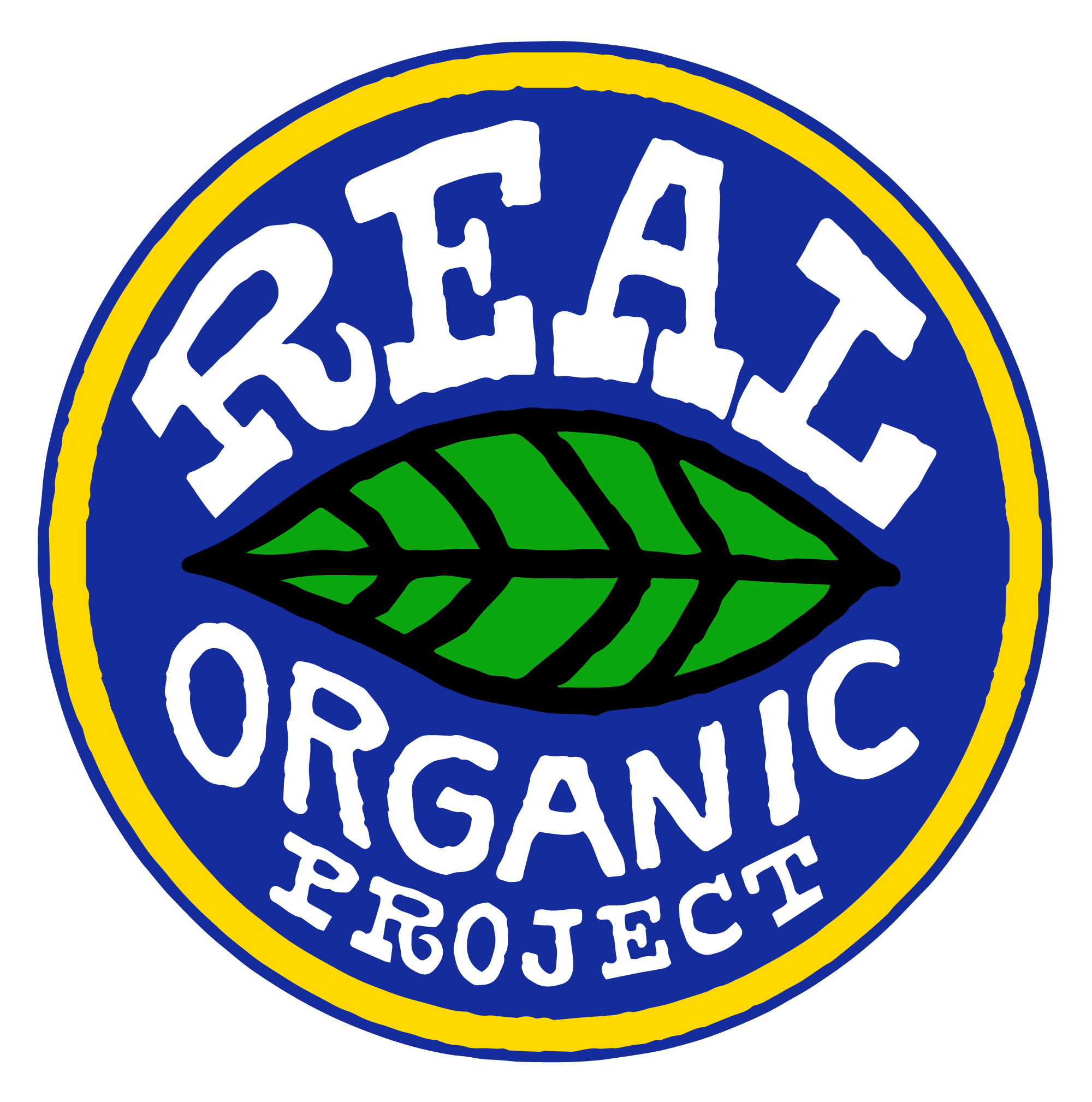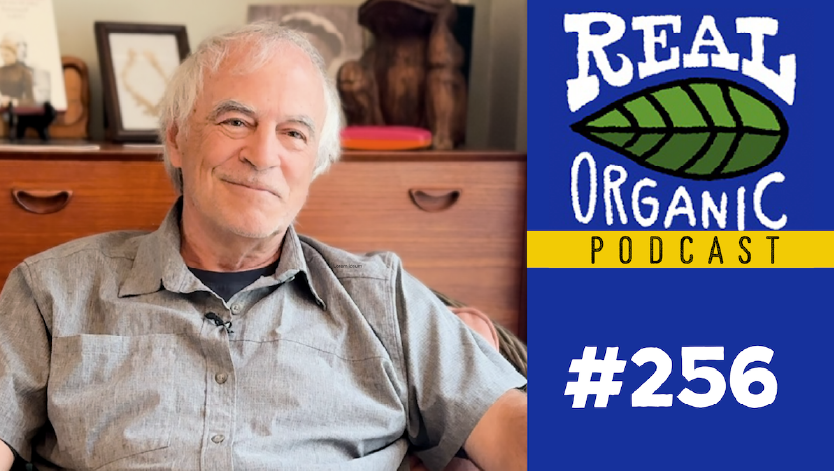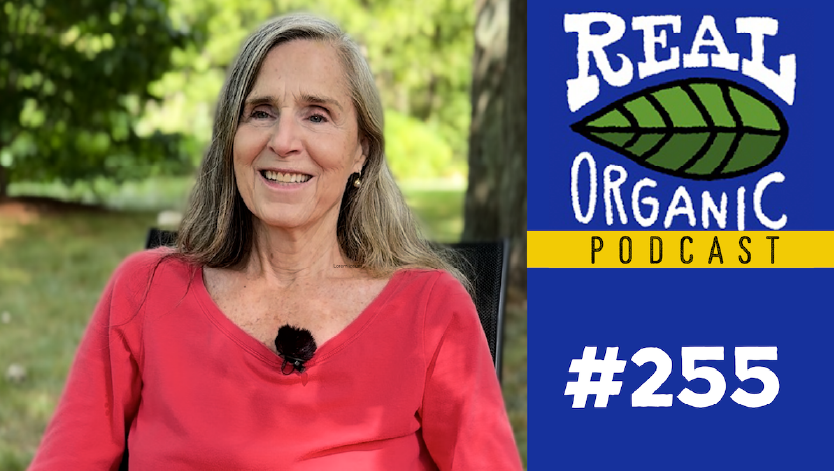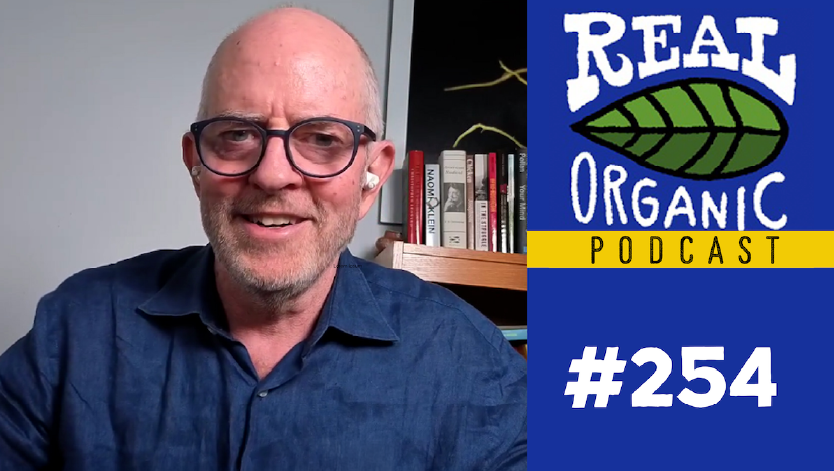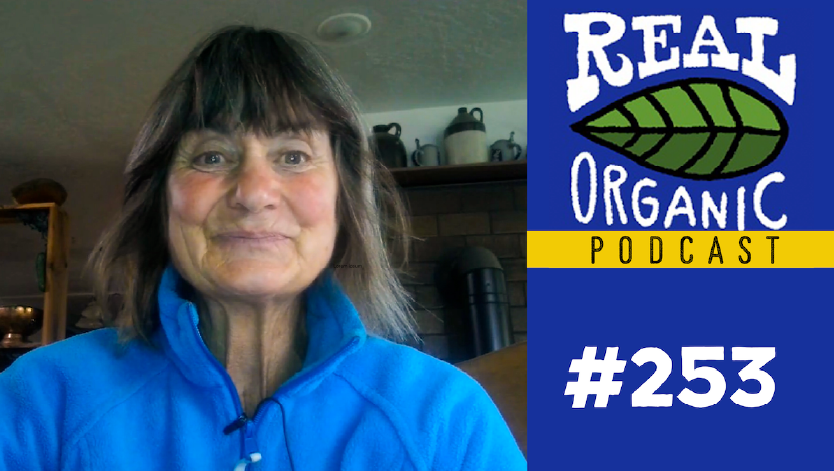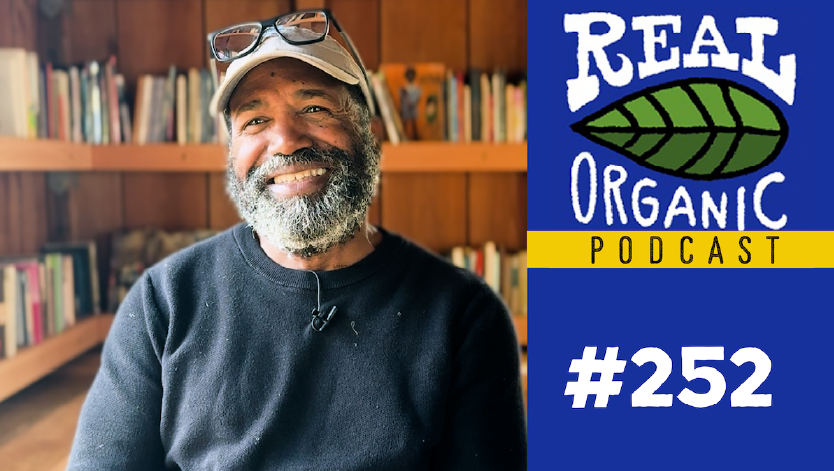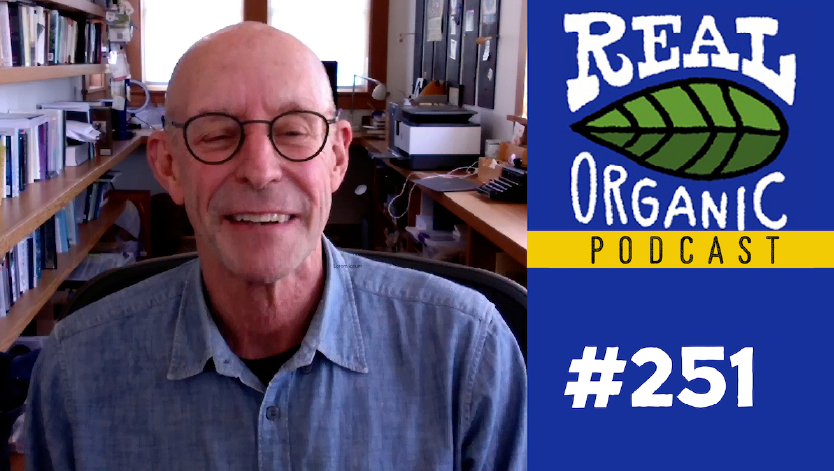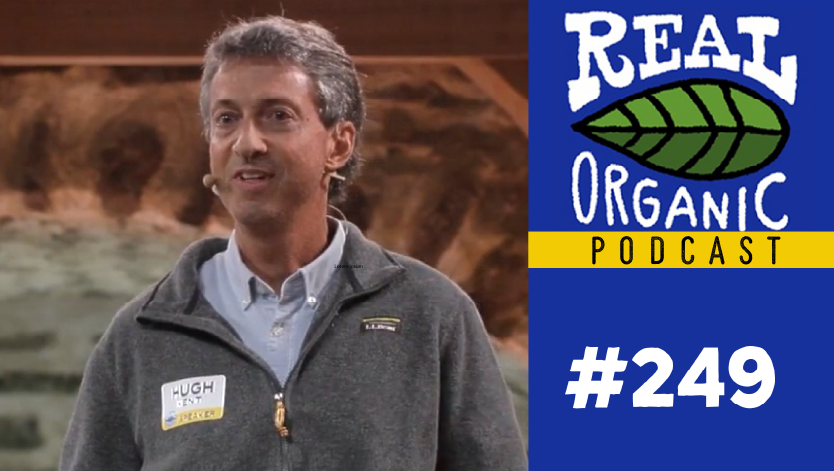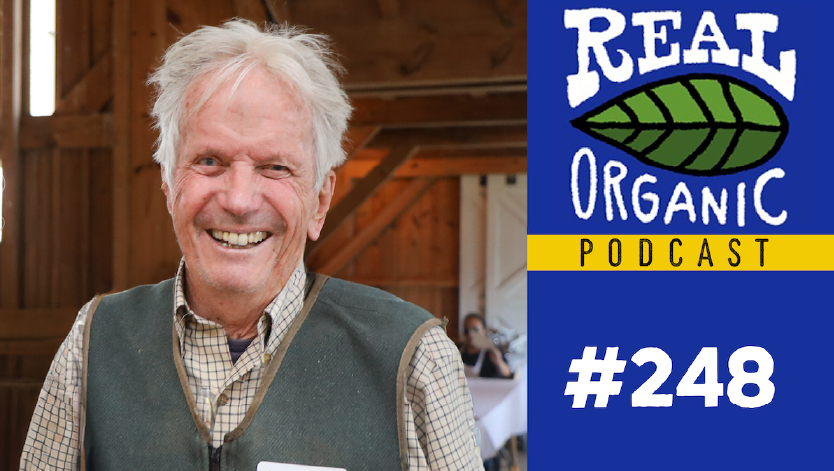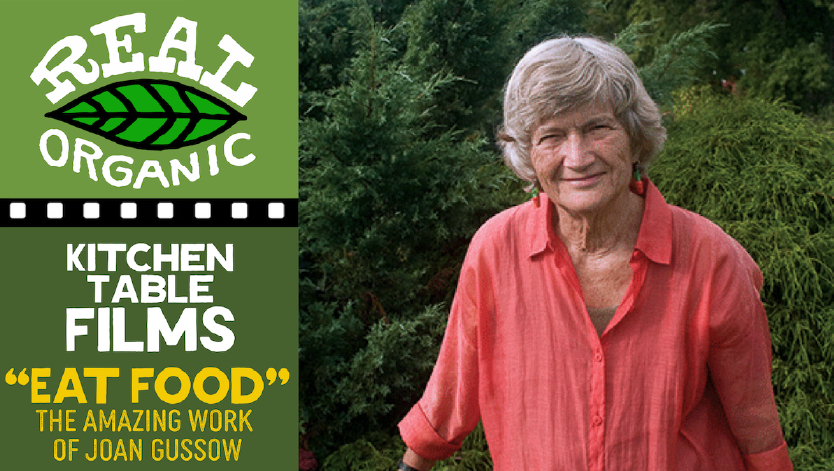Episode #193
Hugh Kent at Churchtown: Losing Our Agriculture
Welcome! You can subscribe and download episodes of our show through your favorite podcast app.
You can also subscribe to receive the video version of each episode on our YouTube channel.
Our Hugh Kent interview was recorded live at Churchtown Dairy on September 28, 2024:
Hugh Kent speaks on the main stage in the Round Barn at Churchtown Dairy, during Real Organic: A World Movement on Saturday, September 28, 2024:
Hugh Kent 0:00
So the next speaker is Hugh Kent. I got to meet Hugh – Hugh and his wife Lisa are blueberry farmers from Florida, and they grow the best blueberries that I’ve ever eaten. And I, you know, I have letters of adoration from many famous people. One of us his greatest fans is Dan Barber from Stone Barns, from Blue Hill. And I got to meet Hugh through this movement…and he approached and got certified. First farm to ever use our label was King Grove, their farm. And he’s become a very good friend and a great champion for Real Organic. So Hugh.
Hugh Kent 0:54
I believe we, we all need to acknowledge that we’re living at the end times of a failed experiment in agriculture, and in feeding human beings on the planet. I’m not talking about the 12,000 years that we’ve been growing food, and which marked the beginning of civilization. I’m talking about the little green sliver on the right end of that bar graph that represents the Green Revolution. This is the dawn of chemical agriculture. Before this time, we didn’t we didn’t grow this way.
Hugh Kent 1:30
You could mark the dawn of chemical agriculture, as some people do academically, maybe in the 1840s, and I think probably most people would acknowledge it gained momentum in the 1930s and then post World War Two, when fossil fuels were harnessed to develop synthetic nitrogen and feed plants. And then the term itself, the Green Revolution, was coined in 1968.
Hugh Kent 1:58
These are, these are recent events within 100 years or so. So if you compress this 12,000 years of human agriculture to a 24 hour day, we’re talking about five or 10 minutes. And it’s significant to remember I think, that when this happened, when there was this new type of agriculture, this split in agriculture 100 or so years ago, there were there was also the dawn of a reaction, which was the birth of what we called organic agriculture.
Hugh Kent 2:32
Prior to that time, I think we, we had been growing organically, but maybe without much of an understanding of soil depletion, and we had been using vast resources of the world, and of course, in this country, we marched west through virgin land, and we were able to farm organically, without keeping in mind crop rotations and replenishment of organic matter.
Hugh Kent 2:56
And it worked for a while, but at the time the Green Revolution was established and took over, there was a counter movement which was organic. And I think it’s important to remember that split, because we lost, obviously, and and now we have the battle again, and we have another split this time. It’s within organic itself. But the reason we need to acknowledge that this is, this is a failed experiment, is because we see it everywhere. We hear it everywhere from everybody who’s well informed.
Hugh Kent 3:30
Farmers tell us this. We see the effects of chemistry on ourselves, our own bodies, on our workers, on our land. We have scientists from every discipline telling us they say, the climatologists, obviously, but also the ones who study mass extinction, the loss of habitat, loss of biodiversity. Political scientists who tell us about the consequences of this type of agriculture on democracy. on social justice, physicians who tell us about what we know is going on, what we can see every day when we walk down the street, the health of, our public health in general, health of our own bodies.
Hugh Kent 4:07
We know something is very, very wrong. So as we, we also think we maybe, we have some answers. And it lies, it lies in the organic movement that started with Albert Howard and now maybe with Real Organic. But we do have a problem, because we have a split in the organic world. And I’m going to do my best to illustrate this for you with the story of, excuse me, story of a couple of blueberries.
Hugh Kent 4:43
This is a Real Organic blueberry, and it’s grown in Central Florida. It’s grown in soil. It’s certified by the USDA. This is the packaging we used to use before we became a direct-to-customer business. And moved on to something more sustainable, and we added the Real Organic logo there. This is not a small farm. We, we’re not farming with oxen. I think this is something that Dave skips over.
Hugh Kent 5:18
But when we talk about organic in modern times, we’re not talking this is not a movement to take us back towards primitive organic farming. This is the idea here is to, is to go forward with organic augmented by human progress, technology, innovation. Dave Chapman maybe started farming with oxen. If you go to
Hugh Kent 5:39
Dave’s farm today, excuse me, you’ll find one of the most technologically impressive agricultural operations in the country. It’s extraordinary what Dave does. I’m inviting you to Dave’s farm. Same, same, obviously, Elliot Coleman has been, has been at the leading edge of science and agriculture his entire career. So organic agriculture is moving continually forward and becoming more and more scientific and impressive as we go along. I think my wife and I do some of the same thing.
Hugh Kent 6:13
We’re all we’re all innovators, if we continue to stay in this business successfully, but the basis of our system in organics is always soil. It’s always soil. And this is a this is an awesome thing. It’s a miracle. It’s a very hard thing to look at every day and even get used to. We understand a little bit about this, but it is quite miraculous that a plant on this planet takes sunlight, and through photosynthesis and carbon dioxide, water and living soil, it creates the starches, the sugars that are the building blocks for all life on the planet.
Hugh Kent 6:54
We don’t fully understand how that works. It’s really amazing, but we do know that that part of it is healthy soil. And what we know about healthy soil is that it’s teeming with life, in a small handful of soil, there are billions there are billions and billions of microbes. I talked to a cousin of mine who’s a Cornell, recently retired Cornell ag professor, and I said, I’ve been learning that you guys, as academics, you can only identify 10% of the microbes in healthy soil. And she said, No, that’s not fair.
Hugh Kent 7:27
She said, it’s more like 1%. Somewhere between one and 10%. We don’t know what these things do. We don’t know what to call them. We don’t know how they work. What we do know is that, excuse me, they are in a close relationship with these plants. There’s an extraordinary amount of life and communication and trading that goes on. The plants are farming, basically farming the soil for the minerals that they need. They’re changing their own chemistry in response to pests. It’s an enormously complex, sophisticated natural system.
Hugh Kent 8:02
And, and we don’t fully appreciate but, but we know it works. That’s how I feel about it. Tell you a little bit more about this farm. We rely on green manure. So instead of synthetic fertilizers, we are getting most of the nutrition for the plants from the decomposition of what grows in the row middles, between the rows of blueberries. And we developed, designed and fabricated the equipment to mow, mulch and put up on the beds all of this green manure that nature is growing for us to feed the plants.
Hugh Kent 8:45
So instead of importing it from Sri Lanka, like the USDA organic blueberries, or mining it and transporting it, our fertility moves about somewhere between six inches and two and a half feet from where it’s grown to where it feeds the plant. It’s in a very effective system. We use that mulch also for weed control. You see on the on the beds there, is decomposing vegetation that used to grow in the middle. And then central to the whole system is encouraging as much life as possible of all kinds. And again, I don’t pretend to understand it.
Hugh Kent 8:45
I just know that the system works if I encourage…as much life as I can, I support it as much as I can, steward it as much as I can, and I try not to label things as pests, because I know that one pest here is another predator there. So we do things like use wildflowers as banker plants to draw some of the pests in there and keep a nursery full of predators, which can also increase in population, corresponding to any pest that gets out of control. We have visible life on the farm as well. That’s a, somebody getting, getting some lunch.
Hugh Kent 10:05
And then this is a, this is an interesting depiction of what’s so important about having life, not just in your soil, but around the farm as well, in a real organic system. And you probably can see in there…the animal that’s, maybe, maybe looking for lunch. What’s more significant to me when I looked at this was without even trying to capture this, if you look in the upper right hand corner of that photograph, you see a small fly. I don’t know what kind of fly that is. I don’t know what that does there. I don’t know if that’s lunch for that animal or not, maybe, but, but I, but I trust that this will all stay in balance. And it does. It works that way. Anytime anything gets a little bit, population rises, then the predators rise in correspondence with them. Nature is always seeking a balance.
Hugh Kent 10:57
If you look even closer in that photograph about where the tail of that animal is, that large leaf his tail is resting on. You’ll see little notches on that leaf. And I don’t know who made those notches. I know it was a plant predator of some kind. There was a grasshopper or something that made those notches. But what we’re learning now is that these mild stresses that are part of a natural system trigger a reaction in the plant’s own chemistry. So, for example, little nibbling on a leaf or a stem we understand now triggers the release of ellagic acid, which is the plant’s…response to the predator.
Hugh Kent 11:43
And…if you look at the work of Dr William Li, who’s a very well-known physician and researcher in this area, and he’ll tell you, he wrote the book Eat to Beat Disease, which is a treatise on treatment and prevention of cancer with food. And he said this ellagic acid is an extraordinarily powerful bioactive compound, and what triggers it, and why it’s in such high levels in a real organic system, is because it’s the plant’s own defense mechanism, which it passes on to the food, passes on to the berry, which, of course, passes on to us when we eat it.
Hugh Kent 12:24
This is also, this is similar to the antioxidants that we find in good soil-grown, real organic blueberries. I used to take credit when people would say, you know, the amazing thing about your berries is they’re they’re delicious. And, oh yeah, go back to that. Dan Barber says, well, ellagic acid, the acids, that’s what makes a berry taste delicious. It’s not just the sugars. You have to have the acids to balance the sugars. So that same…ellagic acid, which is identified by the physicians and nutritionists as being essential for our bodies, is also reflected in the deliciousness, as Dan would say. So that’s why you taste that blueberry and it, and you can taste it, and it’s the taste lingers, and it goes on and on. So that that’s the ellagic acid also.
Hugh Kent 13:12
So I used to take credit for the freshness of the berries that that we now ship to our customers, because we’re very conscious about how we handle them. We…it’s a very different system than is used commercially. We innovated a system where we harvest and chill our berries immediately, within a few hours, as opposed to a few days. And I said, Well, it’s because we handle them so carefully. That’s why, that’s why they last so long. And now we’re understanding…, and that’s not the full story. The same antioxidants that are so good for us in healthy berries are the ones that the plant produces to preserve its own fruit, to preserve its own DNA, to try and replicate itself on the planet.
Hugh Kent 13:56
So it seeks a way to preserve the berry, and it does that with antioxidants. So in conventional agriculture, people spray things like fungicides, like Pristine which are really powerful chemistry, and that’s how they try and get some shelf life. Well, the plant can do it if we allow it to, if it’s got healthy soil. We also, we also spend a lot of time and effort on stewarding the rest of our, of our property. Lisa, my wife, is a wildlife biologist, so this, excuse me, comes naturally to her.
Hugh Kent 14:27
But more than anything, I could summarize it by just saying that in our real organic system, it’s, it’s an effort to respect and to preserve this continuous cycle of life and to keep as much of it around us as we can. And this is not a this is not a compromise as far as yield goes. This is a very…productive farm, and it yields berries in excess of the state average for Florida for conventional blueberries most years, and it’s, of course, very satisfying for us. We…get to care for people by the way we grow our food. We get to care for, steward for the land. We get to work with people that we really enjoy, and we know we’re providing a good, healthy environment for all of them as well.
Hugh Kent 15:22
So here’s the story of the second blueberry. And if you remember the split around 100 years ago between chemical agriculture and organic agriculture, now we have one between USDA agriculture, I’m sorry, USDA organic and real organic. So this is a USDA certified organic blueberry. This is the predominant system for growing organic blueberries in the country and in the world. And I’ll show you in a few minutes about just how, just how dominant the system has become. Also labeled USDA Organic.
Hugh Kent 16:02
This is from a farm of identical size a couple hours away from us in Florida. In order to prepare this farm, the ground was laser leveled compacted, which makes it unsuitable for growing anything, covered in plastic. By the way, there’s no industrial espionage here. This is taken from a promotional video that this farm has online. And so, so it’s covered in plastic. And there are plastic pots that are set out there, and then the whole thing is covered with plastic. So a big plastic sandwich.
Hugh Kent 16:45
And if you look closely at these, these pots, they have IV tubes. This is the, these little plastic tubes, they provide all of the nutrition for these plants. There isn’t anything bioactive of any significance going on in this soil that’s in those pots, all the nutrition is in a liquid feed. That’s what defines it as hydroponic. And it’s dripped through those pots. If they stop dripping that liquid feed through there, within a matter of days, the plant would decline and die. The plant’s life is timed very short anyway, because it’s going to get root bound in a system like that, and then the entire thing will get thrown out, including all of the plastic can’t be recycled.
Hugh Kent 17:28
This is It’s enormous, enormous environmental abuse. I don’t know how many people we think realize or would would appreciate paying a premium for organic berries if they knew they were supporting this type of exploitation of the environment. But there it is. That’s a USDA Organic blueberry. This is one. It’s got the USDA Organic seal. This is one. It has the USDA Organic seal, indistinguishable on the shelf, unless you know what’s going on.
Hugh Kent 18:01
And that growing system in containers, that hydroponic system, that’s, it has some variations, but sometimes it’s done entirely outdoors, but they all…have plastic weed mat that goes out there, and then plastic containers of some sort, and then the newest iteration, and this is the one that’s all over Central and South America. These are plastic bags with coconut coir. The coconut coir is an inert growth medium. It comes from Sri Lanka. Comes from halfway around the world. It’s compressed into little bricks for transport, and then it’s rehydrated out in the field like that. So the sides are pulled down.
Hugh Kent 18:39
The irrigation is turned on for a few days. It rehydrates, swells back up. They pull the sides of the bag back up, put a plant in there, and that’s an organic farm. And then another iteration of that same, same type of thing, more plastic bags. And here is that…soil on the lower right there. That’s the, that’s the brick of soil, the sanitized coconut husks from Sri Lanka, and USDA organic.
Hugh Kent 19:14
So I’m going to word use the word corruption here in this narrow definition as basically the abuse of a word changed from its original use or meaning that’s erroneous or debasing the original word. I don’t think there’s any way to defend this is as organic, and before I go any further, in case I forget, all of this is an illustration. This is, this is what’s happened with organic blueberries. I could tell you exactly the same story, Dave could do it with more detail, because that’s his that’s his realm, organic tomatoes.
Hugh Kent 19:55
Most all of the beef steak organic tomatoes you can find in this country are grown hydroponically, same type of plastic-based system, soil-less. Same for peppers, cucumbers, greens, especially greens. This is an enormous, enormous, Big Ag takeover. In case I forgot to say that. So this is…when we see those pictures, I think most of us trust our eyes and we say, well, we know it when we see it. One ofthose is organic, and one of them isn’t.
Hugh Kent 20:26
But one of the nice things about organic is that it’s not just a word like regenerative or all-natural or sustainable, or none of these words have any legal definition to them. They don’t have any consequences for misusing the word. Organic is supposed to. There’s a whole body of laws that defines organic. There’s a whole structure of certification that we all know about. So we can also look at the laws to show us whether these systems that we’re looking at and that are taking over in this split in organic agriculture. Whether these are really, these are really legitimate, just how much you have to torture the words in these laws in order to make this, make all this fit.
Hugh Kent 21:14
So one of the laws, one of the central laws, is that production practices must maintain or improve the physical, hydrological, biological features of production operation. So soil, water, wetlands, woodlands and wildlife, that’s all supposed to be part of the system. So maybe we look at those really quickly, one by one. Soil. And this is the kind of thing you’ll find in a real organic farm, stewardship of active, bioactive soil. This is a USDA organic soil. It’s a brick of coconut husks from Sri Lanka. Water when it rains on a farm like this, it’s very beneficial to all the life that lives there. It also goes through all of the sand where we live, basically 100 foot sand filter, till you get to the static water table. The water arguably, is cleaner when it gets down to the aquifer than when it was on the surface. Same with the water that we cycle through for irrigation.
Hugh Kent 22:18
I’m not sure what happens when they water the rain falls here, it goes through a lot of plastic, probably washes most of the unused fertigation solution that is dripping through those pots into the soil, which is basically being treated as a septic tank, or maybe it runs off. It has to run off. Most of it has to run off. Rain’s really hard in Florida. This is what captures our runoff, ephemeral wetlands that we that we steward, very important ephemeral, meaning that they dry up seasonally.
Hugh Kent 22:51
So that means that there’s no fish in them. Without fish, that means there’s lots of lizards and frogs, which means that there are very few insects. So it reaches, naturally, a wonderful balance. It’s not a buggy place at all. Supports a lot of wildlife. Wetlands there, I guess it all just drains down into that, that lake down there, below the farm. Next is woodlands. This is stewardship of woodlands on a real organic farm. I don’t know what to show you here. Next, and wildlife. So the wildlife is beneficial, obviously, for its own sake, but also it complements the farm and keeps the whole natural system working. And then, obviously, I’m at a loss again for wildlife here, maybe something like this, maybe.
Hugh Kent 23:50
And that’s, so that’s…one of the central demands of the statute. Another one is, another one is the three year transition period Dave referred to. So organic, for an organic farm to sell its produce as organic it has to use land that has not been treated with any prohibitive substances for three years, at least three years. And we knew they were doing it, and I believe they’re still doing it. This is one of those instant organic plastic farms. What happens?
Hugh Kent 24:32
What’s been happening, and I believe still happens with some real support, is on Monday, they can come through and plow that all up. On Tuesday, they can treat it with glyphosate or Dicamba, 2-4-D, whatever harsh chemical herbicide they want to. On Wednesday, lay out that plastic ground cover. Thursday, put the pots up there. And then put the plant in there on Friday, and they’ve got an instant organic farm. And the USDA called on this, has taken the position that if it’s grown on the land, then you have to observe the three year transition period. These aren’t on the land. They’re, if you we zoom in there, that’s a six inch pedestal, six inches above the ground. I can’t see any other reason why they’d have that, other than to get those six inches off the ground.
Hugh Kent 25:33
And then I think one of my favorites that makes this whole USDA organic huge berry industry work in Central and South America and in California, now is violation of a very specific, very, very specific, very on point provision in the regulations, which says that you cannot use plastic ground cover for weed Control unless you take it out every year and potentially carves out an exception for vegetable growers annual crop growers, because there’s some reasons why that’s a different kind of plastic first of all, but there’s some reasons why it should be allowed there, but on a perennial crop, like a blueberry, no, and make it very clear.
Hugh Kent 26:15
And what’s even more blatant and disturbing is that this is not just in the regulations. This is in the actual enabling statute. This is the higher order law. This is what Congress passed. It passed it says that you can’t do this. You can’t you can’t use plastics mulches, unless the mulches are moved at the end of each growing or harvest season. And just to give you an idea of how committed the USDA is to protecting this big ag industry, this big organic industry, they look at this and their contortion is, they say, Oh, well, the growing or harvest season that marks the time at which you have to remove this stuff, that’s the Life of the plant.
Hugh Kent 27:01
Does any farmer, does any person on the street believe that a growing season is, what 15 years for or 25 years for a citrus tree, or 15 years or 10 years for a blueberry plant, or for any perennial crop? Well…that’s what they’re doing. So saying, you know, this is allowed. Big blueberry didn’t like this Big blueberry wanted to grow with their system. They didn’t want to work with real agriculture. They found a more lucrative way. So we all know who big blueberry is.
Hugh Kent 27:42
I may have just won a bet about whether I could work…Violet Beauregard from Willy Wonka into a presentation. But, big blueberry demanded that that the USDA allow this. So this is what we see now. This is where your organic blueberries come from. They come from this system at massive, massive scale in Mexico, Chile and Peru. And I’m talking about a scale which, which dwarfs domestic production.
Hugh Kent 28:15
These, these farms cover entire valleys in Mexico, and they thrive, or they exist, or they’re, they’re really lucrative, based, I believe, on, on, my opinion, on exploitation, exploitation of the environment, exploitation of the workers. They usurp Mexican farmers’ labor. They hired Guatemalan and Honduran labor generally, because they’re more distressed and they’ll work for less. They they use all of this plastic. They’re serving the water. This is where it all comes from. And these graphs are dated now. They’re actually more extreme than this, but you it’s very hard to get the data out of the USDA. This has exploded in the years since this graph shows 2021, so the last three years, way more, way more.
Hugh Kent 29:03
That’s, red is the Mexican blueberry production. Florida is in the blue. This is not just in the spring growing season. We show on the top there, that’s Michigan in blue, and that line is Peru. And then down on the bottom, Mexico and Florida again. So this is, this has enormous consequences. That’s a, this is one of the reasons why, we like to say, some people, agricultural interests in this country like to say, we feed the world, we’re now operating at an enormous trade deficit, record trade deficits. So we import way more than we export, about $25 billion this year. It’s projected to be 32 billion, in 2025 it will be 42 and a half billion dollars.
Hugh Kent 29:26
So we’re, this is an enormous imbalance in this country we don’t grow and we, we’re not in those figures I just quoted. We’re also including export of things like GMO, corn and soy. We include those in our exports. We include ethanol or ethanol production. So that skews the data even further. But we have we’re importing now more than 60% of the fruit that we consume, so this side of the room, maybe almost 40% of the vegetables, the food that we know is good for us.
Hugh Kent 30:40
The Real Organics Project, reaction to this is to try and give people an idea of what’s going on and to give them a choice in the food that they eat. So the Real Organic Project will not certify a farm like this. This is what they’ll certify in blueberries, tomatoes. They will not certify an operation like this, even though it produces most of the organic tomatoes now. This is what they will certify.
Hugh Kent 30:40
We’ve left out, or I’m sorry I’ve left out, one of the reasons why you can taste the difference between milk and dairy products that you find from a farm like this and from Francis Thicke’s Radiance Dairy, you know, in Iowa. It’s because there’s a lack of brutal treatment of the animals, and also because we…they are also what they eat, so they have this very different diet to choose from than animals that are kept in confinement and living in their own fecal dust. So this is a USDA Organic poultry operation where most of the chicken eggs come from now. The USDA is fine with three chickens per square foot that never see the outdoors. That’s not acceptable to a lot of us. So this is the pasture requirement illustrated in the real organic poultry operation. Same for beef and for dairy products. These are the organic feed lots which have taken over and produced most of those organic products in this country. Now this is a Real Organic certified dairy operation.
Hugh Kent 32:43
So I want to leave you with this idea. There was a split before and societally we chose, or maybe we didn’t choose it, but some powerful interest chose for us chemical agriculture over organic agriculture, a time-honored system, and that was done about 100 years ago, and we now know that’s a dead end. We know it’s a dead end. So what are we going to do as an alternative. And I think a lot of us know this can work, but we do have another split. We have another fight on our hands. We have the USDA organic, and we have real organic. So I think that’s why we’re gathered here, not sure what to do, but like we, like we say on our farm, each, excuse me, each morning, let’s make a plan and get to work. And we don’t have much time.
